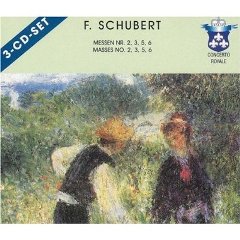Franz Schubert – Masses Nos. 2, 3, 5, 6 (2006)
Franz Schubert – Masses Nos. 2, 3, 5, 6 (2006)

CD 1 Mass No. 2 in G major D 167 Kyrie Gloria Credo Sanctus Benedictus Agnus Dei Mass No. 3 in B Flat major D 324 Kyrie Gloria Credo Sanctus Benedictus Agnus Dei Eva Csapo – soprano; Cornelia Berger – alto; Peter Naus – tenor; Gerhard Faulstich – bass Bach Collegium Berlin Martin Behrmann – conductor CD 2 Mass No. 5 in G major D 678 Kyrie Gloria Credo Sanctus Benedictus Agnus Dei Kari Lovaas – soprano; Hilde Heling – alto; Richard Graeger – tenor; Gerhard Faulstich – bass Bach Collegium Berlin Martin Behrmann – conductor CD 3 Mass No. 6 in E Flat major D 950 Kyrie Gloria Credo Sanctus Benedictus Agnus Dei Kari Lovaas – soprano; Sylvia Anderson – alto; Richard Graeger – tenor; Bruce Abel – bass Bach Collegium Berlin Martin Behrmann – conductor
Mass No. 2 in G Major (D. 167)
The early Mass in G-Major has always been a favourite with the experts. The key appears to have been particularly convenient for Schubert, and it is surely the most traditionally folksy one, perhaps even more so than the 'herder's key' of F Major. With the most economical means - at first only the strings and the organ were planned to be used, Schubert later added timpani and trumpets - the composer achieves extraordinary effects. The intensity of this sacred arrangement is mainly found in its simplicity, the modest, personal experiencing of religious contemplation. The Mass in G-Major was written in 1815 and was intended for a performance in the parish church of Lichtental. In contrast to the performance of the Mass in F Major, there is no proof that the performance really took place.
Mass No. 3 in B flat major (D. 324)
Today, the autograph of the Mass in B flat major is kept at the British Library in London. His early compositions for masses are not quite free of Haydn's influence, whose masses Schubert himself had sung at Lichtental. Especially Haydn's 'Harmony Mass' appears to have made a lasting impression on Schubert.
There are several indications of this in the Mass in B flat major, occasionatly even direct copies in the music. The unusually portato tempo of the Kyrie might be a reference to Haydn's work, and the dotted rhythm of the first choir passage in Haydn's mass is echoed by a like passage in Schubert's music.
In autumn of 1822, Schubert's brother Ferdinand wrote from Pressburg after having visited Hainburg, the town where Joseph Haydn had studied music with his cousin: '...The former invited me to his service taking place on the following Sunday, the fourth day of my stay. And when I asked him what mass he would be doing, he replied: a very beautiful one, by a popular and famous composer, but I just cannot remember the name right now. And now, what mass was it? If you had just been with me, I know you would have enjoyed this too, for it was your B flat Mass!...'
Mass No. 5 in A flat major (D. 678)
Throughout his life, Franz Schubert's relationship to the Catholic church and possibly to the Catholic religion was one of mixed feelings. In 1825, he wrote in a letter to his parents that he never"forced [himself] to prayer". Nevertheless, he wrote almost 39 works of sacred music showing anything but cool distance. One sometimes has the impression as if Schubert attempted to give his personal piety and his individual faith an equally personal space in his works of sacred music.
The Mass in A flat major is among the most difficult compositions of masses Schubert has written. The demands on the choir are extraordinary, but if it finds the composer's winding paths and follows his ideas of sound to the last detail, then the result is an unrivalled and brilliant vocal work. Schubert contrasts this mass not only with his early works, but also with the appropriate masses written by contemporaries, thus placing himself in line with the great masses by Haydn and Mozart. In some way, he even exceeds this and dares visions of sound alien to Haydn and Mozart. Schubert achieves extraordinary effects in the highly artificial refinement of the folk song, for example, and similarly in the dramatically charged opposition of simple solo song and majestic, full choir sound.
Mass No. 6 in E flat major (D. 950)
As with most of Schubert's mature sacred works, the Mass in E flat major (D. 950) seems to have been a response to inner need rather than external imperative. While building upon the foundation of the A flat Mass, it integrates with remarkable success the symphonic organization of Beethoven with Schubert's seemingly limitless melodic and harmonic invention. Although more compact than that in the Gloria of D. 678, the concluding Gloria and Credo fugues, with their sharply chiselled subjects, suggest a composer who had studied Beethoven's Missa Solemnis. ---franzpeterschubert.com
download: uploaded yandex 4shared mediafire solidfiles mega zalivalka filecloudio anonfiles oboom
Zmieniony (Poniedziałek, 28 Kwiecień 2014 16:35)








